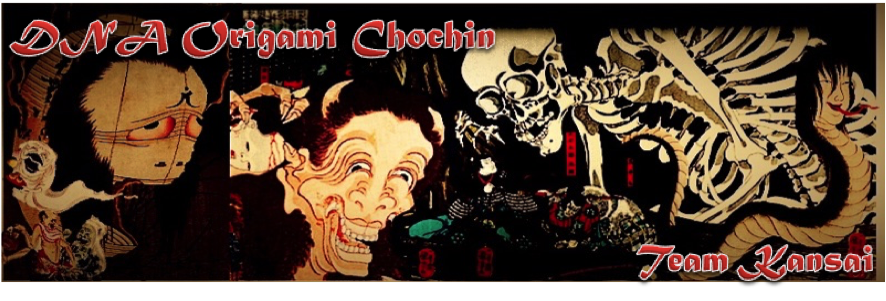Biomod/2015/Kansai/Results

| TOP | Team | Project | Design | Sources | Experiment | protocol |
About Chochin Obake
Followings are some of the ukiyoe masterpieces several hundreds years ago.

Painted by Hokusai Katsushika in “Hyakumonogatari” (1831-1832)

Painted by Kuniyoshi Utagawa in “Kamiyaiemon Oiwanoboukon” (1848)
Most popular image of Chochin Obake is like this.

Painted by Tobosha (Wikimedia Commons)
Commonly, Chochin Obake have a oval shape of Japanese paper Lantern splitting into top and bottom pieces, and has a big long tongue sticks out from the opening.
In addition, some Chochin Obakes has also hands, body, or wings.
In the history of Japan, Chochin Obake has been very popular ghost among people, and found in books and drawings for more than several centuries.
In spite of the popularity, few concrete traditional or folklore of Chochin Obake that accord with local areas are found. So they are classified as exiting ghost only in folk pictures.
Nevertheless, it is still a popular ghost in modern Japanese culture. So you can see it in children’s picture books, haunted house, and even as an anime character in Japan.
Basic design

At first, we designed DNA origami structure that is to be cylindrical shape.
The part it becomes the tongue is a part of scaffold, and it is inside cylindrical structure. The tongue is come out when it is split into top and bottom pieces.
The structure is designed not to separate up and down when cylindrical structure is opened.
The structure contains backbone part that prevent to separate up and down. And also, we use different staples to enable opening.
We expressed features of chochin obake that they are split into top and bottom pieces, and have a big long tongue sticks out of opening.
We introduce DNA staples that they dissociate in response to specific DNA by strand exchange reaction to the part of mouth of chochin obake.
However, the tongue is so small that we cannot observe it.
To solve this problem, we consider that the tongue is grown using DNA tile.

DNA tile structure
In these, Winfree and S. Murata et al reported the molecular self-assemblies that DNA tile grows regularly from a seed structure in 2007.
This study is high molecular calculation with DNA tile.
This DNA tile has functionality of algorism by programing system of input and output beforehand.
As the process of this, following studies reported by researchers including S. Murata.
・ Simulation of the molecular calculation by DNA tile self-assembly.
・ Construction of the large scale DNA sheet with T-motif tile.
・ Development of artificial nucleic acid for molecular calculations.
And more.
This year, we pay attention to this function, and decided to adopt DNA tile to DNA Origami structure.

HCR
HCR stands for hybridization chain reaction.
The points of HCR are two hairpins.
When a single-stranded DNA initiator is added to the stable mixture, it opens a hairpin of one species.
The DNA grows by crossing the complementary strand with another hairpin.
This growth lasts until the hairpin supply is exhausted.
The feature of this method is that it cannot grow without trigger.
This method has many attentions as new biosensor.